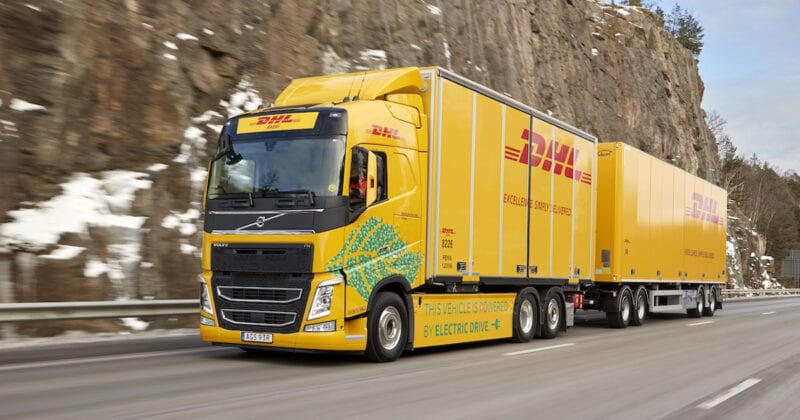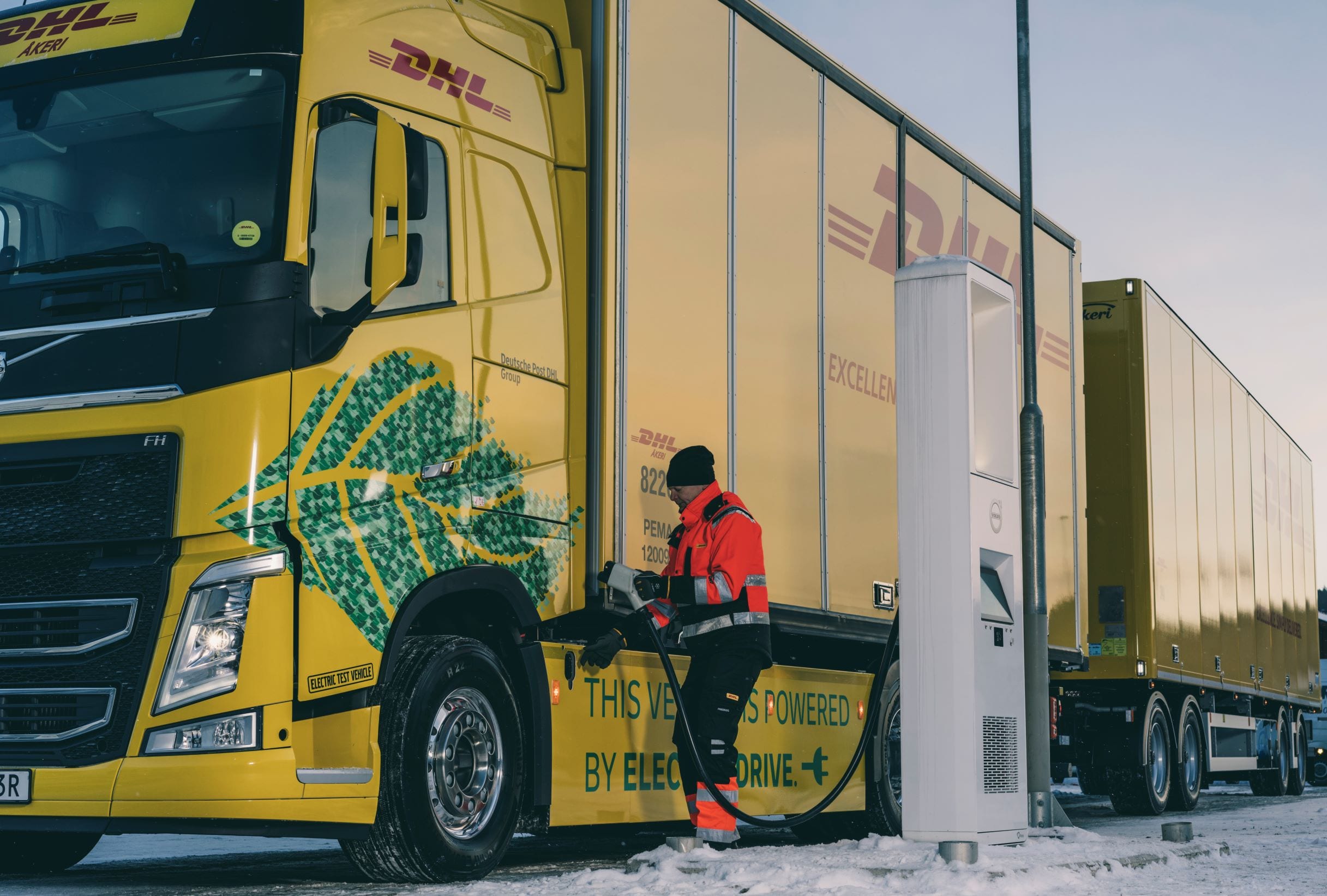サステイナブルモビリティ:よりクリーンな輸送への道

環境に配慮するグリーン輸送はそれ自体が難しいことであり、ましてや世界中に貨物を運ぶために燃料に大きく依存しているロジスティックス業界にとってはなおさらです。しかし、業界の大手企業はこの変化に先導して取り組み、顧客やパートナー企業を説得することが求められます。
グローバル輸送において化石燃料を完全に排除することは、短期的には現実的ではないかもしれません。
発展途上国に不足するエネルギー資源やニーズの違い などの政治的要因や、燃料のエネルギー密度などの技術的要因を考慮する必要があります。例えば、46.9 リットルのタンクを持つガソリン車 は、35.1 kgのガソリンで 570 kmを走行できますが、一方、35.1 kgのバッテリーを搭載した電気自動車は、33.8 kmしか走行できません。
水素燃料や EV 用長距離バッテリーなどのグリーン輸送技術は依然として初期段階にあり、充電インフラの整備状況や生産コストの高さが、持続可能なモビリティの実現にとってさらなる障害となっています。
課題はありますが、今後の進むべき道は見えています。 DHL のように輸送業界の多くの企業は、環境への影響を軽減しながらより大きなモビリティを実現するという共通の目標を持っています。
「私たちは、2030 年までに排出量を 2,900 万トン以下に抑えるために、クリーンなオペレーションの開発に 70億ユーロを投じることを約束しました。その一環として、輸送全てをデジタル化すること、また輸送キャリアおよびパートナー企業と協力して燃料の配合を改善し、効率化を図ることを計画しています」と述べるのは、DHL Supply Chain のアジア太平洋地域の最高顧客責任者(Chief Customer Officer)である Steve Thompsett です。
業界をよりクリーンで持続可能な方向へと導くためには、さらに多くの施策が可能であり、また実際に行われているところです。そのためには、エコシステムのサポートが必要ですが、業界のリーダーがすでにこれを推進していることは朗報と言えます。
カーボンニュートラルの推進
DHL は、スウェーデンのトラックメーカーである Volvo 社や石油大手の Shell 社と協力して、オペレーションにおけるカーボンニュートラルの実現を目指しています。協力し合いながら、より持続可能性が高い航空燃料の使用や輸送のデジタル化、倉庫へ太陽光発電の導入などのソリューションを提案しています。
Volvo 社が提供する幅広い種類の電気自動車のトラックは、DHL の様々な輸送手段に対応できる多様性を備えています。同社はさらに、電気インフラが希薄なルートでも使用できる水素燃料の電気自動車トラックの開発も進めています。
「大型電気トラックは、2040 年には100 % の車両において、脱化石燃料を使用するという目標に到達するための戦略の一部です」と、Volvo Trucks 社の日本・シンガポール・タイ担当の取締役 Marco Bonaveglio 氏は、6 月上旬に4 日間に渡り開催された、持続可能性のあるモビリティーに関するイベント「ムービングオン サミット(Movin'On summit)」で開催されたパネルディスカッションの席上で語っています。
このような提携関係は、DHL のラストマイルオペレーションのデジタル化に役立つだけでなく、DHL Group が電気トラックの運用面および技術面の課題をより深く理解するのに役立ちます。これは、電気自動車(EV)がロジスティックス業界への必然的な参入のベースを築くものです。
電気自動車は脱炭素社会に向けて中心的な役割を果たしますが、技術やインフラに課題があるため、電気自動車が標準となるには一定の時間がかかると思われます。
その一方で、Shell 社は持続可能な航空燃料(SAF)という別のソリューションを提供しています。 使用済み食用油、都市部のゴミ、木質バイオマスなどの再生可能な資源から作られた航空燃料(SAF)は、ライフサイクルでの排出量を最大80%削減することができると言われています。この航空燃料(SAF)は、単独または従来の灯油との混合でも、民間航空機の燃料として使用することができます。
また、Shell Aviation 社のアジア太平洋・中東地域担当ゼネラルマネージャーの Doris Tan 氏は同サミットで、SAF の使用を世界的に推進するため、業界のさまざまな利害関係者と協力している、と述べています。
Shell 社の持続可能な航空燃料への取り組みは、より環境に配慮した燃料の使用に留まりません。
Shell 社はまた、水素燃料などの新技術に多額の投資を行う一方で味ゼロエミッション目標を支援する組織である「クリーン・スカイ・フォー・トゥモロー(Clean Skies for Tomorrow)」というプロジェクトを設立しました。
ロジスティックスの将来は環境に配慮するグリーン輸送に
クリーンな輸送技術の開発・普及には多くの取り組みが行われてきましたが、カーボンニュートラルの実現にはまだ多くの課題が残されています。その中でも、技術力の限界が大きな課題となっています。
電気自動車の限界についての質問に答える形で、Bonaveglio 氏は大陸間や大陸横断の輸送に共通する懸念事項として、航続距離を挙げました。電気自動車は通常、ガソリン車に比べて航続距離が短く、充電にも時間がかかります。世界的に充電インフラが整備されていないことにより、その状況はさらに悪化しており、この問題は電気自動車の広範な普及の障害となっています。
代替案として水素燃料の可能性を指摘する声もありますが、Bonaveglio 氏は「水素燃料はすぐに実現できる選択肢ではない」と言います。この技術はまだ初期段階にあり、完成は 2020 年代後半までかかると考えられています。
クリーンな技術のもう一つの問題は、需要の少なさです。電気自動車 が持つ限界に関する議論に加えて、Tan 氏は「新しい技術とは、生産規模が拡大すると、コストが下がります。しかし、そのためには、まず大きな需要がなければなりません」と指摘します。
この点は、クリーンな輸送技術にとって課題となっています。 「ただでさえ貨物輸送の予算がギリギリの状況であり、環境に配慮するグリーン技術のためにコストを捻出するのは非常に難しいことです」と、Thompsett は述べています。
ご存知でしたか?DHL はFCL 貨物に持続可能な海洋燃料オプションを提供しています
ご存知でしたか?DHL はFCL 貨物に持続可能な海洋燃料オプションを提供しています
DHL Global Forwarding が提供している海上貨物の持続可能な海上輸送燃料サービスが、フルコンテナ(FCL) 貨物でも利用可能になりました。二酸化炭素排出の計算機能が備わっている myDHLi の見積もり・ブッキング機能を使うことで、お客様は持続可能なバイオ燃料の使用を簡単に選択することができます。
この二酸化炭素削減の取組みは、DHL がパートナーを通じて海上輸送燃料を購入し、FCL 貨物で消費する燃料消費量と一致させることで実現します。
「例えば、SAF は通常の灯油に比べて1〜2 倍のコストがかかります」と Tan 氏は言います。
不確実な時代において、クリーンな輸送手段に向けての課題を全て解決するには時間がかかることが予想されますが、業界のリーダーたちによるカーボンニュートラルの推進はかつてないほど高まっています。
「DHL はカーボンニュートラル推進の取組みを宣言しており、サプライヤーの皆様にもこの取組みに参加していただきたいと考えています」と Thompsett は述べています。





 日本語
日本語